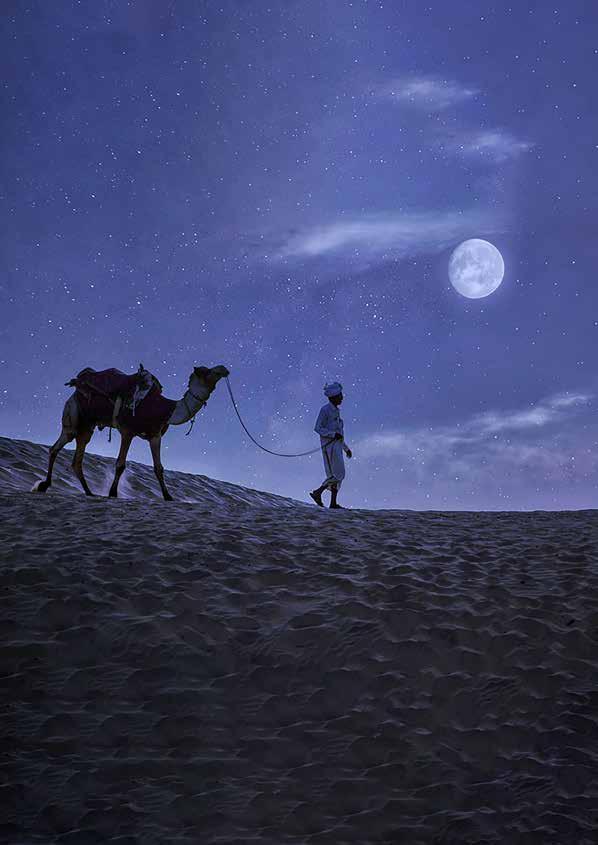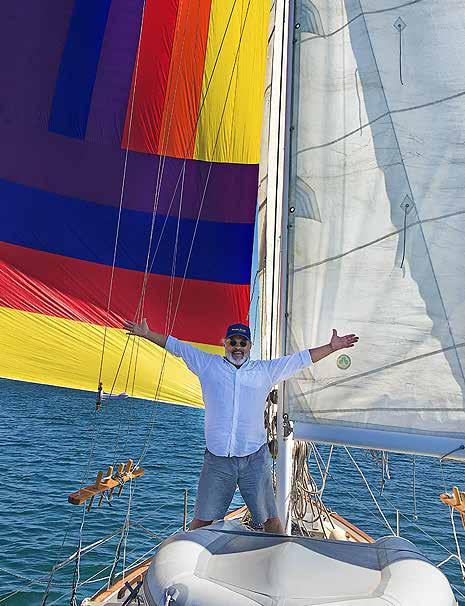

March 2024 Free Online Magazine From Village Earth Dr Namrata Goswami Scramble for the Skies Discourse on Space Resource Utilization 2010 - 2023 Cover photograph by Jill Gocher

©liveencounters.net march 2024 Celebrating 14th Anniversary L I V E E N C O U N T E R S M A G A Z I N E
Photograph by Mark Ulyseas.
©Mark Ulyseas


Support Live Encounters. Donate Now and Keep the Magazine Live in 2024
Live Encounters is a not-for-profit free online magazine that was founded in 2009 in Bali, Indonesia. It showcases some of the best writing from around the world. Poets, writers, academics, civil & human/animal rights activists, academics, environmentalists, social workers, photographers and more have contributed their time and knowledge for the benefit of the readers of:
Live Encounters Magazine (2010), Live Encounters Poetry & Writing (2016), Live Encounters Young Poets & Writers (2019) and now, Live Encounters Books (August 2020).
We are appealing for donations to pay for the administrative and technical aspects of the publication. Please help by donating any amount for this just cause as events are threatening the very future of Live Encounters.
Om Shanti Shanti Shanti Om
Mark Ulyseas Publisher/Editor
markulyseas@liveencounters.net

All articles and photographs are the copyright of www.liveencounters.net and its contributors. No part of this publication may be reproduced without the explicit written permission of www. liveencounters.net. Offenders will be criminally prosecuted to the full extent of the law prevailing in their home country and/or elsewhere.
2024 march © liveencounters.net March 2024

©liveencounters.net march 2024 Celebrating 14th Anniversary
Dr Namrata Goswami
Mark Ulyseas
Jill Gocher
Tang A Pau
Peter Daly
Scott Dodgson

2024 march © liveencounters.net
Contributors March 2024

©liveencounters.net march 2024 Celebrating 14th Anniversary G U E S T E D I T O R I A L
Dr. Namrata Goswami
Dr. Namrata Goswami is an author, professor, and consultant specializing in space policy, international relations, and ethnic identity. She teaches at the Thunderbird School of Global Management, Arizona State University, and the Joint Special Forces University and is a consultant for Space Fund Intelligence. She is a guest lecturer at Emory University for seminars on Technology, Society & Governance, and India today. She worked as a Research Fellow at MP-Institute for Defence Studies and Analyses, New Delhi; a Visiting Fellow at Peace Research Institute, Oslo, Norway; La Trobe University, Melbourne, Australia; University of Heidelberg, Germany; Jennings-Randolph Senior Fellow, United States Institute of Peace; and was a Fulbright Senior Fellowship Awardee. She was awarded the Minerva grant by the Office of the U.S. Secretary of Defense to study great power competition in outer space. In April 2019, Dr. Goswami testified before the U.S-China Economic and Security Review Commission on China’s space program. Her co-authored book, Scramble for the Skies: The Great Power Competition to Control the Resources of Outer Space was published in 2020 by Lexington Press; Rowman, and Littlefield. Her book on The Naga Ethnic Movement for a Separate Homeland was published in 2020 by Oxford University Press. She has published widely including in The Diplomat, the Economic Times, The Washington Post, Ad Astra, Asia Policy, Live Encounters Magazine, Cairo Review. She was invited in November 2019 to share about her life and her work at a Tedx event held at the Rosa Parks Museum, in Montgomery, Alabama. She has appeared on CNN, BBC, Deutsch Welle, France24, and Channel 4, to share her research on space policy. She is currently working on two academic book projects, one on China’s Grand Strategy and Notions of Territoriality and the other on Spacepower Theory and Practice: Case Studies of U.S. China, India, Russia, and Japan.
Dr Namrata Goswami
How the Discourse on Space Resource Utilization has evolved since Scramble for the Skies The Great Power Competition to Control the Resources of Outer Space was written
In October 2020, my co-authored book Scramble for the Skies: The Great Power Competition to Control the Resources of Outer Space was published. In that book, we argued that we were noticing a shift in space policy discourse, from Cold War space missions informed by a push for acquiring prestige, to post-Cold War missions that focused on space resource utilization and development. In the book, we argued that as we move forward, nations and their societies would start viewing space from an economic perspective and would establish capabilities to access the resources in our solar system. They would view space from a critical infrastructure perspective. There would also be the emergence of a vibrant commercial space sector globally.
The book’s research assumptions now stand vindicated with the U.S., China, and India, establishing policies and programs that are looking to utilize space resources. Since October 2020, after the book was published, the U.S. has established both policies and missions that talk about space resource utilization. In April 2022, the White House released an In-Space Servicing, Assembly, and Manufacturing National Strategy to support U.S. space manufacturing services. The U.S. Artemis Lunar Program to utilize the resources on the Moon has seen the launch of Artemis 1 in November 2022. Several more Artemis launches are scheduled in the next few years toward building a sustainable Lunar human presence.
2024 march © liveencounters.net
© Namrata Goswami N A M R A T A G O S W A M I
In November 2022, the White House issued the National Cislunar Science & Technology Strategy that specified the vital economic and space utilization aspects of the Moon. Amongst the priorities of this strategy were to extend cislunar space situational awareness (SSA), implement cislunar communications, positioning, navigation, and timing, and foster new commercial development. The U.S. House of Representatives Oversight and Investigation Subcommittee of the House Natural Resources Committee held a hearing on space resources to include topics like Lunar and asteroid mining in December 2023. NASA issued a feasibility study on Space-Based Solar Power (SBSP) in January 2024. Most notable of the policies was the U.S. State Department’s Strategic Framework for Space Diplomacy, the first such document issued by the State Department in May 2023. The Framework asserted U.S. leadership in space and its intention to build partnerships with like-minded countries and allies. There was a recognition in the document that space systems contribute to U.S. critical infrastructure, and that the growth of the commercial sector and several nations investing in space renders space a vital component of U.S. diplomatic efforts.
China moved ahead on its long-term space goals by successfully carrying out a Lunar sample return mission (December 2020), landing on the surface of Mars (May 2021), and building its permanent space station in Low Earth Orbit (LEO), the Tiangong space station (2022). China announced plans to build an International Lunar Research Station (ILRS) in June 2021, the idea being to build a permanent Lunar base by 2036. China planned to establish the International Lunar Research Station Cooperation Organization (ILRSCO) to establish the regulatory framework for its ILRS partnerships that include Russia, Pakistan, South Africa, Venezuela, Azerbaijan, Belarus, and Egypt. Some of the goals of ILRS are in-situ lunar resource utilization, cislunar space environment assessment, lunar chemistry, and lunar topography. ILRS would consist of a cislunar transportation facility, and related lunar ground facilities, both robotic and human-enabled. China announced plans to send humans to the Moon by 2030. In 2024, China is launching the Chang’e 6 to the lunar far side to collect samples. In 2023, China moved ahead with its SBSP plans. The Chinese plans also included the development of SBSP satellites, across different space institutions involved in the project. The China Academy of Space Technology (CAST) is now focused on developing the base technologies for the construction of a large SBSP satellite, and laser and microwave power beaming. Hou Xinbin, a researcher at CAST and member of the Committee of Space Solar Power of the Chinese Society of Astronautics specified that the next step will be to place these satellites in space, experiment with microwave and laser beaming to ground stations on Earth, or develop a capacity which is even more beneficial; laser beaming realized between two satellites in orbit.
©liveencounters.net march 2024 Celebrating 14th Anniversary
G U E S T E D I T O R I A L

2024 march © liveencounters.net © Namrata Goswami N A M R A T A G O S W A M I
Artemis Base Camp. Photograph ©
https://www.nasa.gov/specials/artemis/

Chinese Tiangong Space Station (Phase 1) since 3 November 2022. https://en.wikipedia.org/wiki/Tiangong_space_station#/
©liveencounters.net march 2024 Celebrating 14th Anniversary G U E S T E D I T O R I A L
Another interesting development was the presentation of findings of a three-year feasibility study project (2021-2023) called “Tiangong Kaiwu” or “The Exploitation of the Works of Nature”, by Wang Wei, a leading scientist with the China Aerospace Science and Technology Corporation (CASC). The project aims to build an end-to-end space logistics system spanning the entirety of the solar system by 2100, by utilizing key strategically positioned gravitationally balanced regions in space. This would include capacities to extract water ice from the Moon, and mining resources from Near Earth Asteroids, Mars, the asteroid belt and the Moons of Jupiter. The vision is to enable a wide-scale space infrastructure that would facilitate extraterrestrial mining and processing. Wang specified that “just like the miracles created in the great age of navigation, a ‘great space age’ featuring the use of space resources will … create the next miracles in human history and bring new prosperity to our civilization…[this] has the potential to transform the global space economy and elevate China’s standing in the world of space exploration”.
India moved the furthest on space resource utilization and long-term space plans since Scramble for the Skies was published. At the time the book was published, India had not made its position on space resources clear; neither did it have a long-term space vision. The book pointed out how India lacked a strategy for long-term investment in space development compared to either the U.S. or China. I wrote an article titled “Asia’s Space Race: China Leads India on Strategy”, for the Lowy Institute, Australia, in March 2022, where I stated that:
Where China and India differ is how they locate space in their grand strategic discourses. While India is focused on developing traditional space goals, such as satellite launches, sending humans to Low Earth Orbit (LEO) and prestige missions like those to the Moon and Mars, China’s development of its lunar and Mars capacity highlights the growing role of space in its critical infrastructure. China, unlike India, aims to extend its space systems beyond borders –beginning with its Tiangong program – and towards a commercialised export model. India has recently developed institutions to support its own national security and commercial space sectors, but its path continues to be determined by traditional space launch goals. Whereas both China and India, by investing in space launches, missions to the Moon and Mars, ASAT weapons tests and satellite-supported navigation systems, ticked several boxes towards becoming part of the traditional space club dominated by the United States and Russia, China now expresses ambitions to leave the club. Instead, its aim is to lead space-related technologies, such as quantum communications, robotics, on-orbit servicing, assembly and manufacturing, artificial intelligence (AI), and space-based solar power (SBSP).
© Namrata Goswami
2024 march © liveencounters.net
N A M R A T A G O S W A M I
All that has changed now with the year 2023 ushering in policy, strategy, and capacity developments upping the ante regarding India’s long-term space development. No longer is India’s space vision just about the traditional goals I had identified in the article in 2022. The Chandrayaan 3 Lunar Mission landed on the Southern hemisphere of the Moon on August 23, 2023. It was India’s second attempt to land on the Moon, after the failure of the Chandrayaan 2 mission in 2019. The ability of the Chandrayaan 3 Lunar mission to build an end-to-end space logistics capability, with a low-key budget of $75 million, that included the rocket launch, propulsion system, lunar lander, and rover was one such game changer. Since then, India has announced the Chandrayaan 4 mission, which aims to land on the far side of the Moon, accomplish a precise landing technology, in collaboration with Japan, hunt for water, and bring back lunar samples. In 2023, India announced its official space policy. As per that space policy document, the focus of India’s space program is to develop and support its commercial space sector. The 2023 space policy indicates that India’s space vision is “to augment space capabilities; enable, encourage and develop a flourishing commercial presence in space [emphasis added]; use space as a driver of technology development and derived benefits in allied areas; pursue international relations, and create an ecosystem for effective implementation of space applications among all stakeholders.”
About the issue of space resources, the 2023 Indian space policy made India’s position clear, something that was missing when Scramble for the Skies was published. The 2023 space policy provides India’s position on the extraction of space resources. On pages 6 and 7 of the 2023 space policy document, India stakes its position, to include clarifying ownership issues: “Non-Governmental Entities (NGEs) will be encouraged to engage in the commercial recovery of an asteroid resource or a space resource. Any NGE engaged in such process shall be entitled to possess, own, transport, use, and sell any such asteroid resource or space resource obtained in accordance with applicable law, including the international obligations of India.” The Indian Prime Minister’s Office released a space roadmap, announcing a lunar sample return mission (the Chandrayaan 4) by 2024, a space station by 2028, and finally a manned mission to the Moon by 2040. The Chandrayaan 5, 6, and 7 will be future lunar missions that will be building the capability to accomplish India’s goal of lunar infrastructure, human presence, and lunar tourism. India’s lunar program now includes a technology build up phase between 2023-2028, a Lunar reach-out phase (2028-2040), and a Lunar base between 2040-2047. The Chandrayaan 5, 6, and 7 missions will be within the lunar reach-out phase. From Chandrayaan 6 onwards, India will start to build lunar habitats, followed by the Chandrayaan 7 aimed at lunar infrastructure building.
©liveencounters.net march 2024 Celebrating 14th Anniversary
G U E S T E D I T O R I A L

2024 march © liveencounters.net © Namrata Goswami N A M R A T A G O S W A M I
Chandrayaan-3 mission being moved to launchpad on LVM-III. Photograph © ISRO

©liveencounters.net march 2024 Celebrating 14th Anniversary G U E S T E D I T O R I A L
Illustration of Artemis astronauts on the moon by NASA.
As per ISRO Chairperson, S Somanath, “2040 is 17 years away and that’s a good time to develop technologies to send humans to Moon. Our work on the proposed space station too is progressing aggressively and we should be able to have the first unit ready by 2028”. India is developing a Human Rated Launch Vehicle for its Gaganyaan human spaceflight mission. This will include building capacities like life support, Bioastronautics, Crew training, and Human rating & certification. India has signed the U.S. Artemis Accords that have Lunar resource utilization as a key goal.
Japan’s space policy also saw some significant changes. On June 23, 2021, Japan enacted the Space Resources Act on Promotion of Business Activities Related to the Exploration and Development of Space Resources (Act No. 83 of 2021) that came into effect in December 2021. This act defines space resources as “water, minerals, and other natural resources that exist in outer space, including on the moon and other celestial bodies.” The Space Resources Act clarified Japan’s permission process stating that “an applicant for the space resources extraction permit must attach a business activity plan to the application. The activity plan must include the purpose of the proposed space resources exploration and exploitation activity; the term, location, method, and other details of the activity; and other matters specified by a Cabinet ordinance”.
The most critical part of Japan’s Space Resources Act is its unambiguous statement on who owns the resources they mine on a celestial body, an issue hotly debated for long in the space community. Japan stated that “The Space Resources Act provides that the person who obtained the permit owns the space resources that the person exploits in accordance with the approved activity plan. (Art. 5.)”. Consequently, Japanese commercial space company, ispace became the first private space company in the world to be granted a license under Japan’s Space Resources Act to go extract resources on the Moon, establish ownership, and then sell the resources to NASA. This will be the first business activity on the Moon. Takeshi Hakamada, ispace’s Founder and CEO, stated at that time. “With this license, we will transfer ownership of the lunar regolith we expect to collect to NASA during our first mission…commercial space resource utilization is another step toward our goal of establishing the cislunar economy and will support NASA’s goal of a long-term presence on the Moon.” ispace attempted to land on the Lunar surface in April 2023, but lost communication between the lander and the mission control team, and hard landed on the Lunar surface.
2024 march © liveencounters.net
© Namrata Goswami N A M R A T A G O S W A M I
In a span of nearly three and half years, since Scramble for the Skies was published, we now witness several nations account for space resource utilization and space development. This also includes Middle Powers like Luxembourg and the United Arab Emirates (UAE). The UAE Mars mission called Hope Probe which entered Mars orbit in February 2021 has gathered new data on Mars, to help improve our understanding of the Mars atmosphere specifically the mysterious aurora called Sinuous Discrete Aurora. It is truly astounding to witness the level of changes to space policies and capacities around the world. We have the United Nations Space2030 agenda, where member nations aspire to build a sustainable future in space. Specifically, the Space2030 Agenda states and I quote
Through COPUOS [Committee on the Peaceful Uses of Outer Space], UNOOSA [United Nations Office for Outer Space Affairs] supports policy discussions on emerging space affairs issues, including extraction of space resources, space traffic management and the governance of small-satellite ‘mega constellations’. It is, therefore, crucial for the United Nations to continue engaging with stakeholders to support and promote dialogue among Governments, industry and the private sector, academia and civil society to effectively tackle challenges and address changes in the space environment.
It will be interesting to see how all this plays out once we have a permanent presence on the Moon, something nations are aspiring for by 2036. While we know how hard it is to land on the Moon, nations like the U.S., Russia, China, and India have accomplished the feat, and with Japan’s Smart Lander to Investigating the Moon (SLIM), and Intuitive Machines Lunar landing added to the mix, but not without landing glitches for the last two. With the kind of vision articulated by both China and India, it appears like Asia is taking the lead in this post-Cold War push for space development. Time will tell if they can sustain their ambitious space plans.
©liveencounters.net march 2024 Celebrating 14th Anniversary
G U E S T E D I T O R I A L

Book available here: https://rowman.com/ISBN/9781498583114/ Scramble-for-the-Skies-The-Great-Power-Competition-to-Controlthe-Resources-of-Outer-Space
2024 march © liveencounters.net © Namrata Goswami N A M R A T A G O S W A M I

©liveencounters.net march 2024 Celebrating 14th Anniversary A C O U N T R Y I L E F T B E H I N D …
Photograph by Mark Ulyseas.
©Mark Ulyseas
Mark Ulyseas has served time in advertising as copywriter and creative director selling people things they didn’t need, a ghost writer for some years, columnist of a newspaper, a freelance journalist and photo-grapher. In 2009 he created Live Encounters Magazine, in Bali, Indonesia. It is a not for profit (adfree) free online magazine featuring leading academics, writers, poets, activists of all hues etc. from around the world. March 2016 saw the launch of its sister publication Live Encounters Poetry, which was relaunched as Live Encounters Poetry & Writing in March 2017. In February 2019 the third publication was launched, LE Children Poetry & Writing (now renamed Live Encounters Young Poets & Writers). In August 2020 the fourth publication, Live Encounters Books, was launched. He has edited, designed and produced all of Live Encounters’ 292 publications (till March 2024). Mark’s philosophy is that knowledge must be free and shared freely to empower all towards enlightenment. He is the author of three books: RAINY – My friend & Philosopher, Seductive Avatars of Maya – Anthology of Dystopian Lives and In Gethsemane: Transcripts of a Journey.
https://liveencounters.net/mark-ulyseas-publisher-editor-of-live-encounters-magazines/ https://www.amazon.com/Mark-Ulyseas/

Mark Ulyseas A country I left behind…
(General elections are expected to be held in India between April and May 2024 to elect 543 members of the Lok Sabha.)
The aroma of hot shingaras served in a tarpari leaf with green chutney and tamarind sauce, the warm jaggery sweetened tea served in kulhars and the charcoal grilled delicately rolled kathi kebabs is what spices the reminiscences of a childhood in West Bengal.
The further one moves away from this land the greater is the pull to reclaim the romance of the olden days. But is it really that what one perceives as sacred memories or has the grinding wheels of progress ground the hard life of yore into a fine dust of romanticism?
Existing in no man’s land between the remnants of the Raj and the rightful heirs of the land, brought with it a garbled version of cultural values. Values that were, in a manner of speaking, alien to others around. And it was this that created a lifelong schism between the me, myself and I. A man marooned in a sea of tongues. Born of the land but an outsider to it in many ways.
From travelling by steam train, cycling to far off rural areas, playing cricket in villages, aping western sixties’ attire, seeking refuge in mud huts from the monsoon, to breaking bread with the homeless, whilst speaking the language of the Raj, never learning to hear the voices of the land. Shrugging off the calls of ancestors to pay heed to the spirits.
That was then. This is now.
2024 march © liveencounters.net
© Mark Ulyseas M A R K U L Y S E A S
The native returned sometime ago to vainly grasp the strings of wayward kites floating gracefully in the early evening sky. The attempt to envision a lost world somewhere in the menagerie of bustling markets, glittering airports, fast electric trains, manic traffic and the surging human masses that wound through the brightly lit streets around massive buildings. Never a moment to think. Perhaps this is the AI that spooks many of us?
The good old days were never good, and neither are the days of today. Both are impostors that feign a sense of belonging, nothing more. For one is born in time, and it is this time that one continues to exist in, the outsider looking outside in to other times. Parallels of existence have become different streams of thought, each provoking the other, each attempting to subdue the other with imagined understanding of the purpose of life, the purpose of the existence of a nation, too.
Meanwhile, the juggernaut of progress rolls on through the land flattening individuality and silencing the voices of dissent. Progress means new constructions, elevation of social backwardness to one of roti, kapada, makaan, aur gadi (food, clothing, house and car).
Religion is not the opium of the masses, it an aphrodisiac that makes many of us like rutting apes.
My home has changed from conceivable to irreconcilable. Many have become disposable humans living from day to day like rats in a laboratory. The ruling class, politicians, ever so often offer the rats a chance to change their life with their voting power. This is like a release valve, nothing more. After the ballots are countered the rats obediently return to their rat wheel of life, back to the grind of survival.
In the olden days only one political party ruled so really there was not much to do during elections. And not many benefits, like freebies.
The continuity of madness prevails.
©liveencounters.net march 2024 Celebrating 14th Anniversary
A C O U N T R Y I L E F T B E H I N D …

What is the force that propels a people to strive towards development, development that is a wedge between sense and insensibility. The creation not just of wealth but of disparities between people’s living standards, between human rights and animal rights, between spirituality and commercialism of the soul.
We talk of Space as if this in itself will lift us out of our parochial lives hemmed in by cultural aberrations. The legacy of our past teachers is slowly being replaced with the purchase of ‘sell by date’ products. The ape is mesmerised by the colour and sound of the likes of tiktok and not the chime of a clock marking Time.
Can one truly turn one’s back on this ancient land of the Sanatan Dharma? The sound of temple bells in the cool morning air. The songs of the faithful whose belief in Fate is humbling. A celebration of faith - vermillion and saffron dust hanging hesitantly in the air and then settling like dew on everything around.
From the hallowed halls of government to the vibrant local markets, faith and truth jostle for space in the minds of the people.
The ancient land I once knew has changed for me, but the spirit of its people lies safely nestled in the Sanatan Dharma.
And the country I left behind flourishes beneath the veneer of progress, a mantra away from the birth of another generation of Time.
Om Shanti Shanti Shanti Om
2024 march © liveencounters.net
© Mark Ulyseas M A R K U L Y S E A S
Photograph © Mark Ulyseas

©liveencounters.net march 2024 Celebrating 14th Anniversary I N D I A
Jill Gocher
Jill Gocher has been living and photographing in Asia for around forty years. She has authored more than ten books and countless magazine articles and photographed for many magazines. She is now working on a book of India’s tribal communities titled Desert Folk Watch out for it.
Jill Gocher
Enigmatic Havelis of Shekawati
Photo Feature
The enigmatic villages of Shekawati used to be on the silk trade route and the merchants grew prosperous from the taxes they charged the camel caravans. They built magnificent havelis - ornate and imposing and had them decorated with colourful murals. the Hindi ones were painted with figures and flowers and the Muslim ones came with more abstract floral patterns. These magnificent havelis are spread through several villages in the Shekawati region. You can take a car and spend glorious days exploring these beautiful forgotten buildings. while some are restored to make beautiful hotels, others lie forlorn and forgotten just awaiting discovery or some enterprising person to give them life again.
2024 march © liveencounters.net © Jill Gocher J I L L G O C H E R

©liveencounters.net march 2024 Celebrating 14th Anniversary I N D I A 01.

2024 march © liveencounters.net © Jill Gocher J I L L G O C H E R 02.

©liveencounters.net march 2024 Celebrating 14th Anniversary I N D I A 03.

2024 march © liveencounters.net © Jill Gocher J I L L G O C H E R 04.

©liveencounters.net march 2024 Celebrating 14th Anniversary I N D I A 05.

2024 march © liveencounters.net © Jill Gocher J I L L G O C H E R 06.

©liveencounters.net march 2024 Celebrating 14th Anniversary I N D I A 07.

2024 march © liveencounters.net © Jill Gocher J I L L G O C H E R 08.

©liveencounters.net march 2024 Celebrating 14th Anniversary I N D I A 09.

2024 march © liveencounters.net © Jill Gocher J I L L G O C H E R 10.

©liveencounters.net march 2024 Celebrating 14th Anniversary W I L D - V I E T N A M
Tang A Pau
Tang A Pau is a professional photographer living in Saigon. He has 15 years of experience. He is a volunteer photographer with ICF Asia (International Crane Foundation) and of some National Parks in Vietnam. Tang's stories are usually about the natural beauty of places, and species at risk, and encourage environmental awareness. He hopes through his experience and photographs he can highlight all the great benefits that Nature has to offer in Vietnam. Publications: 2021 - Co-author, Birds of Vietnam Co-author, Atlas of Cattien National Park
Special thanks to Nguyen Thuy Hoa.
Tang A Pau
Wild Exotic Vietnam Photo Feature
Vietnam never ceases to amaze every visitor that seeks to experience its wild flora and fauna.
The exotic plummage on display at its amazing 34 national parks captivates the senses of all nature lovers.
Come, experience wild Vietnam with Tang.
2024 march © liveencounters.net
© Tang A Pau T A N G A P A U

©liveencounters.net march 2024 Celebrating 14th Anniversary W I L D - V I E T N A M
White-throated Kingfisher

2024 march © liveencounters.net © Tang A Pau T A N G A P A U


©liveencounters.net march 2024 Celebrating 14th Anniversary W I L D - V I E T N A M
Emerald Dove


2024 march © liveencounters.net © Tang A Pau T A N G A P A U

©liveencounters.net march 2024 Celebrating 14th Anniversary W I L D - V I E T N A M
Great Lora

2024 march © liveencounters.net © Tang A Pau T A N G A P A U

©liveencounters.net march 2024 Celebrating 14th Anniversary W I L D - V I E T N A M
Green Peafowl

2024 march © liveencounters.net © Tang A Pau T A N G A P A U

©liveencounters.net march 2024 Celebrating 14th Anniversary W I L D - V I E T N A M
Banded Broadbill

2024 march © liveencounters.net © Tang A Pau T A N G A P A U

©liveencounters.net march 2024 Celebrating 14th Anniversary W I L D - V I E T N A M
Siamese Fireback female.

2024 march © liveencounters.net © Tang A Pau T A N G A P A U

©liveencounters.net march 2024 Celebrating 14th Anniversary W I L D - V I E T N A M
White-rumped Shama

2024 march © liveencounters.net © Tang A Pau T A N G A P A U

©liveencounters.net march 2024 Celebrating 14th Anniversary G R A T E F U L
Peter Daly
Of Irish Indian extraction, I live in beautiful, inspirational and rural surroundings in the West of Ireland. My passions are photography and writing, affording me an oasis of peace and tranquility away from chaos. I am inspired randomly across many aspects of life, people, nature and sport, at home and abroad. I publish my work on my Facebook page, Ballygar Banter, which has 8,100 followers, set up ten years ago to help keep our expats around the world in touch with home. Involved with our local voluntary charity “Building for Children” I have written about and photographed their incredible work in Ethiopia These reports have brought great awareness about the plights of orphaned children, many blind and disabled, and helped raise substantial much needed funds towards renovation of their desperate abodes. Many of my photographs and some of my reports have been published or quoted in local and national media.
Peter Daly Grateful - Photo Feature
Birds of Connemara, West Of Ireland.
Sitting In Silence, On the Banks of Tranquility, Watching, Listening, Thinking, Parking Worry, Stress, Re Energised Soul, Re Kindled Heart, Breaking Shackles of Darkness, Leaving Winter, Anticipation, Spring is Nigh, Awakenings, Freedom to Enjoy, The Wonders of Nature, Gentle Flow Shannon Waters, All Calm Beneath, Wild Birds, Excited Flights, Swimming, Grubbing, Nourishing, Resting a While,
Living in the Moment, Moments in Time, Special Moments, Sharing Them. Owning Them, Grateful For Our Life, Grateful For Our Land, Grateful For Our Community, Peace With Us.
2024 march © liveencounters.net
© Peter Daly P E T E R D A L Y

©liveencounters.net march 2024 Celebrating 14th Anniversary G R A T E F U L
Mute Swan

2024 march © liveencounters.net © Peter Daly P E T E R D A L Y

©liveencounters.net march 2024 Celebrating 14th Anniversary G R A T E F U L
Whooper Swan

2024 march © liveencounters.net © Peter Daly P E T E R D A L Y

©liveencounters.net march 2024 Celebrating 14th Anniversary G R A T E F U L
Whooper Swan

2024 march © liveencounters.net © Peter Daly P E T E R D A L Y

©liveencounters.net march 2024 Celebrating 14th Anniversary G R A T E F U L
Whooper Swan

2024 march © liveencounters.net © Peter Daly P E T E R D A L Y

©liveencounters.net march 2024 Celebrating 14th Anniversary G R A T E F U L
Whooper Swan

2024 march © liveencounters.net © Peter Daly P E T E R D A L Y

©liveencounters.net march 2024 Celebrating 14th Anniversary A S A I L I N G L I F E
Scott Dodgson
Scott Dodgson has roamed the seven oceans sailing as far north as the Baltic Sea and Alaska and as far south as Kenya in the Indian Ocean and from South Africa to Chile in the Southern Ocean along 50 degrees south. He wrote the popular movies “The Anna Nicole Story”, “Paris Hilton, Princess Paparazzi,” and numerous other films and television shows. His podcast “Offshore Explorer With Scott Dodgson can be found where ever you get your pods. He has published a novel “Not a Moment to Lose,” a novella (optioned for film) “The Casket Salesman,” and numerous short stories and essays including in Live Encounters. His anthology of short stories “A Sailor’s Point of View” published by Main Street Rag Press is available. His two new novels “The History of Water” and “Le Pécheur” are grinding their way toward publication. He lives in the south of France.
Scott Dodgson A Sailing Life
One winter, during the 60s, I was watching our RCA black and white console television with my sisters. After school and after homework, we could watch television for an hour while my mother cooked dinner. We waited for our father to come home from work. He was an engineer. Looking back, I realized this hour of television time served two purposes for my mother. One, she worked at the bank all day and she had limited child bandwidth. Even on the best of days, Mom longed for peace, often praying to the god of quiet. A God in the pantheon of Gods celebrated more than one might know. Television was a way to corral us into behaving. Two, to my mother’s credit, she embraced the new medium of television as a learning tool. She would often ask us questions about what we watched. When father was late, which was frequent, he’d say, “Building the future wasn’t a nine-to-five job.” His tardiness gave us more time in front of the television. I would intently watch the news. We were a CBS, Walter Cronkite family. Every family had their favorite, CBS, NBC, ABC. The news really came down to Walter and Huntley/Brinkley. Reports were trickling in on the “police action” in Viet Nam. A country I would later serve. A lot of ink was devoted to the domino theory with the terrifying result of communists taking over city hall and the playground. What captured my attention were reports from the Middle East. I barely understood or cared about what crises were occurring. I watched intently a reporter in Beirut telling the audience something earth shattering while standing in front of a bombed building or a pastoral field with sadly decayed crops. What excited me the most was the intrepid reporter stood in a marina where fishing boats docked. He used this backdrop several times. I figured it was close to the action. He wore a tan safari jacket. I longed for that jacket. If I could have, I would have told the cameraman to give me a wider shot! I want to see what this place was like. And could you get the reporter out of the way, please? I wanted to visit the Middle East. Every foreign report piqued my desire. I wanted to visit everywhere. I was bitten by the travel bug.
© Scott Dodgson
2024 march © liveencounters.net
S C O T T D O D G S O N
These reports reached through the television screen with all its information like a thunderous clap to me. Streams of words and pictures flowed directly into the pleasure center of my brain.
I constantly dreamed of foreign lands and their peoples. However, as a preteen, acting on this impulse was impossible. Instead, I learned about geography and studied history. I read ferociously.
I listened to the old men in the neighborhood tell stories about their native homes. Their accents were music to my ears. The food was another enticement. It smelled good and different. Arguments over small things like the best olive oil, or the best part of a cut of lamb chop raged on week to week, never being settled. Spices, sauces, movie stars, cycling, boxing, the best oranges, the best fish, and politics were argued over continuously like a melodious troupe of homing pigeons. It fed my desire. Post-World War II and Korean War immigrants were still being integrated into the neighborhoods of America in the 60s. Nostalgia for far-away homes flowed like an underground stream through our everyday lives. My German fifth grade teacher married a soldier after the war. The bodega down on Oxford Avenue was run by an Italian family from Napoli where German and Allied bombs obliterated their home. The Polish butcher brought his skills to our neighborhood because the communists ran his country.
The world had come to my home. I half expected to see the reporter in that sharp safari jacket reporting in front of my house. Why would I want to leave? The answer was simple. The quest to attain authenticity and to understand the pathos of things. Having the right type of experience and the correct education are the passerelle to enlightenment. Sailing was the predominate method of travel throughout history. It made sense to me that to be truly authentic, one must voyage by boat. I knew, even though I had no proof, there was something magical about sailing around the world.
I admit I am a romantic. My romance is with life itself. At an early age, I swore to myself I wouldn’t let life grind me down as it did to my parents. I have one life and I will live it on my own terms. To be honest, I did not differ from generations of young men who set out from their homes to work ships as deck hands, top men, riggers, or rowers. This was a worthy pursuit through the ages.
The desire to see the world is as old as ships themselves. For thousands of years, men and women have boarded ships for foreign lands seeking a better life and profit or just out of curiosity. The ocean’s call is powerful.
©liveencounters.net march 2024 Celebrating 14th Anniversary
A S A I L I N G L I F E
Having spent a lifetime on the water, my logbook reads; I made eighteen round trip crossings of the Atlantic from the Caribbean to the Mediterranean and numerous voyages around the Mediterranean. Sailing from the Med; I visited the Red Sea, Kenya, Egypt, and the Arabian Peninsula. I made eight round trips to the South Pacific one as far as Sidney, Australia. I raced in the Southern Ocean and made many trips up and down the Central American and North America Pacific coasts.
The great Phoenician sailors communicated by their invention of script writing, allowing other sailors to grasp what they could not see. Ports provided a hub of storytelling. The more stories were told, the more understanding and the more desire to see these wonders for themselves. Who were these storytelling sailors? What kind of men and women were they? Why did landlubbers believe their stories?
Sailors become sailors by sailing. This sounds simple, but there is a lot to unpack about what kind of transformative experience sailing can be. Consider three aspects: the physical, psychological and the intellectual.
Having spent a lifetime on the water, my logbook reads; I made eighteen round trip crossings of the Atlantic from the Caribbean to the Mediterranean and numerous voyages around the Mediterranean. Sailing from the Med; I visited the Red Sea, Kenya, Egypt, and the Arabian Peninsula. I made eight round trips to the South Pacific one as far as Sidney, Australia. I raced in the Southern Ocean and made many trips up and down the Central American and North America Pacific coasts. I’m only counting voyages on sailing yachts from forty to ninety feet. The purpose of listing these voyages is to lend credence to my experience of the many conditions at sea on a relatively small vessel.
Understanding of the effects of motion, pitching, and rolling has on your body and mind is essential to sailors and their sense of perspective. The same experience happens to Sufi Whirling Dervishes. The result is a kind of aura. In history and literature, the nautical character looms large.
Once I was taking a prospective chef to my boat by dinghy, and she was sick before we arrived and demanded returning to land. Sea sickness is a normal response to motion. The eye and the inner ear where your balance lives become off kilter, resulting in nausea. This is an uncomfortable experience for someone not used to being on a boat. I liken the motion to practicing yoga. The physical feeling is much the same. Deep meditation and chanting will also produce similar manifestations. The feeling can be deep and very strong when at sea for a long time.
I began studying this physical change when I took part in a theater experiment designed by the famous Polish director Jerzy Grotowski. (The Theater of the Poor.) “The actor’s research is based on body work that aims to rid themselves of automatic reactions in order to get to the character’s essence within themselves.” Both movement and training produce similar physical feelings.
2024 march © liveencounters.net © Scott Dodgson S C O T T D O D G S O N
The Phoenician sailor told stories to a rapt audience in the local taverna at the port. Like that pre-teen peering into his RCA television, stories opened a whole new world to the imagination. This tradition continues today. Greek, Roman, Chinese, Indian, and every sort of sailor would offer their observations and stories of their experiences. Ancient ports were the hub and natural environment for the sailor as they are today. For thousands of years, civilizations relied on sailors for information about foreign lands and peoples. I was aware of the importance of carrying on this tradition and it informed me at every course correction in my life.
The result for the actor is an energy like transference from the authenticity of the character to the audience. A sailor experiences the same continuous state of energized being, like the actor, and when the sailor embarks, he projects with the same intrinsic transference of energy. The nautical character is born.
Intellectually, sailors have a finely focused sense of time often likened to simply being. Standing on the rolling deck of a yacht with nothing but the arc of the ocean in all directions naturally focuses the intellect to the present. There is nothing to do about the past and the future is simply a waypoint. What is real and refreshing given the hustle and bustle of modern life is the simplicity. The Zen like sense of being and the intellectual focus opens a vast reservoir of psychological propensities. These tendencies can be heightened sexuality, paranoia, aggression, indolence, and impatience, to name a few. After a few voyages, you can watch your crew change over the days and nights. Explaining what is happening to them usually keeps the ship’s company working toward the same goal.
The path to being a captain is in the experience. All licensing regardless of country has a basis in accruing time at sea. Authorities have long recognized the physical, intellectual, and psychological phenomena of sailing. Experience means safety.
Storytelling has long been a tradition of sailing and the sailing life. I was very attracted to storytelling.
The Phoenician sailor told stories to a rapt audience in the local taverna at the port. Like that pre-teen peering into his RCA television, stories opened a whole new world to the imagination. This tradition continues today. Greek, Roman, Chinese, Indian, and every sort of sailor would offer their observations and stories of their experiences. Ancient ports were the hub and natural environment for the sailor as they are today. For thousands of years, civilizations relied on sailors for information about foreign lands and peoples. I was aware of the importance of carrying on this tradition and it informed me at every course correction in my life.
My grandfather owned a sailing dory, which he kept near his home in Ocean City, New Jersey. The Jersey shore is a series of barrier islands buffeted by the ocean. Egg Harbor Bay and the continent lie behind its protection. In this expansive saltwater marsh, my dreams of travel and sailing coalesced into what would become my sailing life. We would sail out into the bay with crab traps. My grandmother would collect chicken skin for us to put into the traps.
©liveencounters.net march 2024 Celebrating 14th Anniversary A S A I L I N G L I F E

2024 march © liveencounters.net © Scott Dodgson S C O T T D O D G S O N Crossing the Atlantic November 1998.
We would spend the day sailing up and down the bay until the tide changed. He would tell me stories about his experiences. He was a sailor and a sportswriter who covered cycling, baseball, boxing, and football. Lots of stories and lots of lessons for a young man who listens. One story, a baseball story has remained with me today. Baseball like sailing seems to distort the sense of time. It is one of the few games that doesn’t rely on the clock.
The St. Louis Cardinals had just swept the Philadelphia Phillies five straight. The Cardinal star Lou Brock hit almost every at bat and stole base after base against one of the best catchers in the league, Clay Dalrymple. In the locker room, the other reporters yelled at Lou Brock, “Hey Lou! Hey Lou!” They showed Lou little respect because he was Black, and even less for Clay, although white was performing poorly they called him a bum. When the scrum of reporters finally dispersed, my grandfather addressed “Mr. Brock.” He asked him for tips on fielding fly balls for the Little Leaguers that read his column. Mr. Brock’s face lit up, and he went into a detailed explanation about running with your head level, keeping your eye on the ball, etc. Then my grandfather asked about all the stolen bases. Mr. Brock told him it was a competition and winning was important because they were in a pennant race, but he felt bad about it. Very few people knew about Clay’s condition, but he was suffering from overwork and arm fatigue. “He’s a competitor.” Said Mr. Brock with great respect and admiration. My grandfather was the only one to get the story. He told me this story, then returned to picking up the traps full of blue crab off the mud flats. It was a simple and entertaining lesson. Respect everyone and they will respect you. The culture of ships is more equalitarian and respectful than life on land.
The simple and satisfying time of sharing work on the sea with my grandfather led me to become a tugboat captain, tour boat operator, water taxi driver, yacht racer, vessel assist operator, support vessel captain, fishing charter captain, charter yacht captain, mega yacht captain, ship restorer, delivery captain, yacht builder, surveyor, and dive charter operator.
The history of jobs on the sea was a driving force for men less fortunate, or the wrong nationality or color. My family was essentially working middle class, coal miners on one side and a simple newspaperman on the other. My parents were the modern ones. Their generation was building the world of technology and finance. Their world was an abstract world. I preferred Herman Hesse’s quote, “Every experience has its element of magic.” I sought and fought hard, sometimes sacrificing comfort and love for exchanging music for noise, creativity for business, and passion to make my world as real as possible.
©liveencounters.net march 2024 Celebrating 14th Anniversary
A S A I L I N G L I F E
Americans especially have a fascination with the Disney version of pirates. I see local sailors hoisting the pirate flag as a party flag. Celebrations of the pirate as a benign swash buckling hero in the movies, and literature are ubiquitous and can be found in any bar near the water. There are documentaries that talk about these misunderstood creatures of the sea with such excitement and glee they created a faux history, “The Age of Piracy” as if it was some socially redeemable moment in history. Pirates were and are murderous scum driven by greed. Piracy exists today and you don’t have to go to the South China Sea to get your throat cut.
Misconceptions abound about sailors throughout history. I have been very careful not to fall into the trope trap of pirates and the yacht club set. These are two influential and counter productive aspects of the modern American sailing world.
Americans especially have a fascination with the Disney version of pirates. I see local sailors hoisting the pirate flag as a party flag. Celebrations of the pirate as a benign swash buckling hero in the movies, and literature are ubiquitous and can be found in any bar near the water. There are documentaries that talk about these misunderstood creatures of the sea with such excitement and glee they created a faux history, “The Age of Piracy” as if it was some socially redeemable moment in history. Pirates were and are murderous scum driven by greed. Piracy exists today and you don’t have to go to the South China Sea to get your throat cut.
I have had a few run-ins with pirates over the years. I was once flagged down by a fishing boat that appeared to be adrift. The boat flew a Lithuanian flag, somewhat common in the Baltic Sea. My vessel was a 90-foot San Lorenzo motor yacht capable of 28 knots. As I got closer, I could see the fishermen were wearing street shoes and new Nike sweats. These were not fisherman. One man raised a revolver and feigned shooting at me if I didn’t stop. I laughed at how pitiful these pirates were.
I have experience with weapons from my days in the service. I remember distinctly qualifying on the range with an army issue forty-five caliber pistol, standing on solid ground, taking careful aim, and firing at a target only fifty feet from me. Out of ten, I hit it seven times. After some practice, I hit the target ten out of ten times. At one hundred feet, I had the same record. I am, by military standards, an excellent marksman. I’ve got the medal to prove it. So, when I saw these men standing in a fishing boat that was rolling and pitching in leather dress shoes on a wet deck slipping and sliding waving a small caliber revolver at me, I knew there was no way he could hit me or the three stories of shiny fiberglass and massive tinted windows floating one hundred feet away from him. I gunned the yacht and left a wake big enough for both men to fall on the deck and hang on for dear life. I called the Coast Guard and reported their position and intent. Returning to my speed and course, I continued my trip without incident.
2024 march © liveencounters.net © Scott Dodgson S C O T T D O D G S O N
Pirates today come in all kinds of perfidious guises. They don’t board your vessel with swords and flint lock pistols twirling their ‘rrrrs’ like a Cornwall fish monger. They are desperate people willing to do anything. The worst form is the police corporal, under the guise of looking for drugs or guns, who needs the smallest pretext to impound your vessel. Or the port captain who shows up at your boat asking for a donation to his church or the customs official spending hours with you in a cramped office in North Africa trying to find the politest way to extort booze from you as the price of entry. In Granada, I fought off two men in the middle of the night who apparently swam at least a kilometer to board my sailboat with machetes. They were exhausted, and I easily defeated them. I opted to give them a ride back to shore so they wouldn’t drown. I gave forty dollars as well and a heap of shame. They apologized profusely.
I detest pirates. I hate to see the skull and crossbones flag on any vessel. To me, it is like celebrating serial killers.
The yacht club set is a group of sailors characterized by their whiteness and wealth. It is a group that has showed little respect for the history of sailing, preferring to manufacture its own selfindulgent history. Please, there are plenty of people of color and nationality that are members of sailing and yachting clubs today. This wasn’t always the case. Being white and being rich set the yacht club crowd apart from the average sailor. My American yacht club experience has been less about sailing and more about selectiveness and racism. I have enjoyed the comradery and social benevolence of yacht clubs around the world, even the exceptionally snooty ones. American yacht clubs are not so welcoming. Yacht club folks conjure a persistent trope of what landlubbers think about boating. Yachting as we know it was a late 19th century creation.
The vessel design that afforded the yacht scene and the subsequent multibillion dollar industry was developed by Black Bermudians in the 18th century. Most vessels used to fight the American Revolutionary war were designed and built by Black Bermudians. The Bermudian Sloop changed naval warfare. Shifting from large British built square-rigged vessel to fast triangular sails with large genoas, the vessels possessed a great speed and the ability to sail close to the wind. Sailing close to the wind was a key tactic in defeating the larger square-rigged vessels with overwhelming firepower. The Black Bermudian ship builders were key influencers and leaders of the Black slave population. They taught shipbuilding trades, as well as reading and writing in small schools set up near the shipyards.
©liveencounters.net march 2024 Celebrating 14th Anniversary
A S A I L I N G L I F E
At fifteen I bought, with a loan from my grandfather, my first sailboat, a 21-foot Herreshoff designed sloop sailboat. My dreams of travel were realized. I sailed to Bar Harbor, Maine, the next summer. I sailed roughly 500 miles one way along the coast. That trip opened my perception of myself wholly unexpectedly.
The famous abolitionist Fredrick Douglass recounted in his memoir “Narrative of the life of Frederick Douglass, an American Slave” that he learned to read and write at a school created by caulkers. The job of a caulker is to hammer cotton into the seams between the planks on the hull of a wooden boat to create a watertight structure. It is a highly skilled job, left mostly for Black slaves. To escape, he adopted the disguise of a sailor. The Bermudian sloop became the vessel of choice for the American merchant navy and the slave trade. Until 1860, roughly 30% of all sailors were Black. Black Jacks, as they were called, used the sailing experience to earn respect and money. Ships have a different view of sailors. Social cohesion on ships depended on powerful hands and back, marlinspike skills, and the courage to face the hardships of sailing in the ocean.
After the American Civil War, Jim Crow laws gutted the navy of Black sailors. Steamships further reduced the need for crew and the tradition of the Black Jack sailor earning his stake in the Americas evaporated. The ultimate moment of the eraser of Black tradition in building and sailing occurred with the rebranding of the Bermudian sloop.
In 1920, The America’s Cup challenge took place in New York Harbor, The Resolute for the New York Yacht Club and the challenger Shamrock IV owned by Sir Thomas Lipton of tea fame. The New York newspapers compared the mast and rigging wires of the very tall masts of the America’s cup sailboats with the wires and tower of the early Marconi radio towers. They promoted the contestants rigs as the Marconi rigs, and the name stuck. The Bermuda rig was relegated to a historical footnote.
As an American sailor, I feel it is important to know yourself and know where you stand in the history of sailors. The American sailor falls in the later chapters of the long history of sailing. Having touched in a port on every continent except Antarctica, I came to understand the principles of seamanship, experience on the ocean, and the tradition. They run like a common vein throughout every country, culture, and time. When sailors gather, usually in a pub, we share common experiences. One common experience shared among hardcore sailors is the first voyage.
At fifteen I bought, with a loan from my grandfather, my first sailboat, a 21-foot Herreshoff designed sloop sailboat. My dreams of travel were realized. I sailed to Bar Harbor, Maine, the next summer. I sailed roughly 500 miles one way along the coast. That trip opened my perception of myself wholly unexpectedly.
2024 march © liveencounters.net © Scott Dodgson S C O T T D O D G S O N
I have spent a lifetime, at least, 50 years living and earning as a licensed captain on the oceans and seas of the world. I have derived a great deal of joy and satisfaction from sailing. The pre-teen who vacuumed up every detail about everything in every country was right. The sailing life is more valuable than gold to me. The understanding of the world is fulfilling and magical.
I experienced that unique state of being. I gained valuable nuanced experience at sailing a vessel for over four straight days. My training helped me to resolve some unforeseen problems. Confidence in problem solving is a major aspect of mariner training. I saw that the surface of the ocean was readable. I understood inherently that the wind was also another invisible source of understandable information. My understanding of myself and sailing grew, changing me over that voyage. I was sailing in two oceans, an ocean of air and an ocean of water. My art and my being were imbued with a special understanding that allowed me to navigate between these two oceans just like so many others before me.
I have spent a lifetime, at least, 50 years living and earning as a licensed captain on the oceans and seas of the world. I have derived a great deal of joy and satisfaction from sailing. The pre-teen who vacuumed up every detail about everything in every country was right. The sailing life is more valuable than gold to me. The understanding of the world is fulfilling and magical.
Post Script: I never did get that Safari Jacket, but I did dock my boat among the fishing boats in Beirut.
©liveencounters.net march 2024 Celebrating 14th Anniversary
A S A I L I N G L I F E

2024 march © liveencounters.net © Scott Dodgson S C O T T D O D G S O N
Puttering around LA Harbor.


March 2024 Free Online Magazine From Village Earth 2010 - 2023
Gocher
Cover photograph by Jill



























































